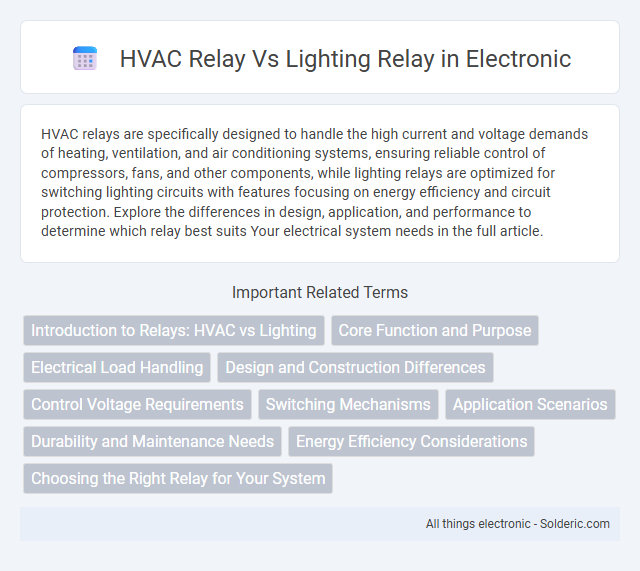HVAC relays are specifically designed to handle the high current and voltage demands of heating, ventilation, and air conditioning systems, ensuring reliable control of compressors, fans, and other components, while lighting relays are optimized for switching lighting circuits with features focusing on energy efficiency and circuit protection. Explore the differences in design, application, and performance to determine which relay best suits Your electrical system needs in the full article.
Comparison Table
| Feature | HVAC Relay | Lighting Relay |
|---|---|---|
| Primary Use | Control heating, ventilation, and air conditioning systems | Switch and control lighting circuits |
| Load Type | Resistive and inductive loads (motors, compressors) | Primarily resistive loads (light bulbs, LED drivers) |
| Voltage Rating | Often rated for 24V to 240V AC/DC | Typically rated for 120V to 277V AC |
| Current Rating | Usually supports higher currents (up to 30A) | Supports moderate currents (usually up to 20A) |
| Switching Type | Single-pole or multi-pole; designed for frequent switching | Single-pole or multi-pole; optimized for slow to moderate switching |
| Durability & Life Cycle | Built for long operational life with high inrush currents | Designed for frequent on/off cycles with moderate durability |
| Typical Applications | HVAC units, thermostats, compressors, fans | Commercial and residential lighting control panels |
Introduction to Relays: HVAC vs Lighting
HVAC relays are specifically designed to handle the high current loads and frequent switching cycles required by heating, ventilation, and air conditioning systems, ensuring reliable control and protection of motors and compressors. Lighting relays are optimized for managing lighting circuits, focusing on switching lower voltage loads with rapid response to accommodate varying lighting demands. Both types of relays utilize electromagnetic principles but differ in contact ratings, coil voltage specifications, and operational durability tailored to their respective applications.
Core Function and Purpose
HVAC relays primarily control heating, ventilation, and air conditioning systems by managing the electrical flow to compressors, fans, and other HVAC components. Lighting relays, in contrast, are designed to switch lighting circuits on and off, ensuring efficient control of electrical loads related to lighting fixtures. Both types of relays serve as crucial switches in automation systems but are optimized for their specific electrical load types and control requirements.
Electrical Load Handling
HVAC relays are designed to handle higher electrical loads often ranging from 20 to 40 amps, suitable for controlling compressors, fans, and heating elements in HVAC systems. Lighting relays typically support lower electrical loads, generally between 10 to 20 amps, optimized for switching lighting circuits with lower power requirements. Proper selection based on load ratings ensures reliable operation and prevents potential electrical failures in both HVAC and lighting applications.
Design and Construction Differences
HVAC relays are designed with robust contacts and thermal overload protection to handle the high inrush currents of compressors and motors, ensuring durability under heavy electrical loads. In contrast, lighting relays prioritize fast switching speeds and low contact wear, optimized for frequent on/off cycles in lighting circuits. Understanding these design and construction differences helps you select the right relay for efficient performance and longevity in your specific application.
Control Voltage Requirements
HVAC relays typically require a control voltage ranging from 24V to 120V, compatible with thermostat and HVAC control systems, ensuring precise operation under varying temperature conditions. Lighting relays usually operate at control voltages between 120V and 277V, designed to handle higher power loads for lighting circuits and facilitate switching in commercial and industrial environments. Understanding these distinct control voltage requirements aids in selecting the proper relay to match system specifications and ensure reliable performance.
Switching Mechanisms
HVAC relays typically use electromechanical switches designed to handle motors and compressors with high inrush currents, providing reliable switching for HVAC systems. Lighting relays often utilize solid-state or electromechanical mechanisms optimized for frequent switching and controlling incandescent or LED lighting loads efficiently. Understanding the differences in their switching mechanisms ensures your system maintains optimal performance and longevity.
Application Scenarios
HVAC relays are designed specifically for controlling heating, ventilation, and air conditioning systems, managing large electrical loads like compressors and fans in residential, commercial, or industrial environments. Lighting relays, on the other hand, focus on switching lighting circuits on and off, suitable for applications ranging from simple home lighting setups to complex building automation systems. Choosing the right relay ensures optimal performance and safety in Your electrical control applications.
Durability and Maintenance Needs
HVAC relays are designed to withstand frequent cycling and high electrical loads, offering enhanced durability for HVAC system demands, whereas lighting relays typically handle moderate loads with less frequent operation, resulting in lower wear. Maintenance needs for HVAC relays often include regular inspection due to constant use and potential exposure to environmental factors like heat and dust, while lighting relays generally require less frequent maintenance because of their intermittent activation. Selecting the appropriate relay depends on understanding load capacity and operating conditions to ensure longevity and reliable performance.
Energy Efficiency Considerations
HVAC relays are designed to handle high power loads with precise control over heating and cooling systems, optimizing energy consumption through efficient cycling and reduced electrical losses. Lighting relays prioritize rapid switching and low power usage to prevent energy waste in lighting circuits and often include dimming compatibility for further savings. Selecting the appropriate relay type significantly impacts overall energy efficiency by matching the relay's electrical characteristics to system demands and reducing unnecessary power draw.
Choosing the Right Relay for Your System
Selecting the right relay, whether HVAC or lighting, depends on your system's voltage, current rating, and control requirements to ensure optimal performance. HVAC relays are designed for heavy-duty loads and frequent cycling in heating and cooling systems, while lighting relays typically handle lower current and focus on switching multiple circuits. Understanding the specific electrical characteristics and application needs of your system will help you choose the most efficient and reliable relay.
HVAC Relay vs Lighting Relay Infographic

 solderic.com
solderic.com